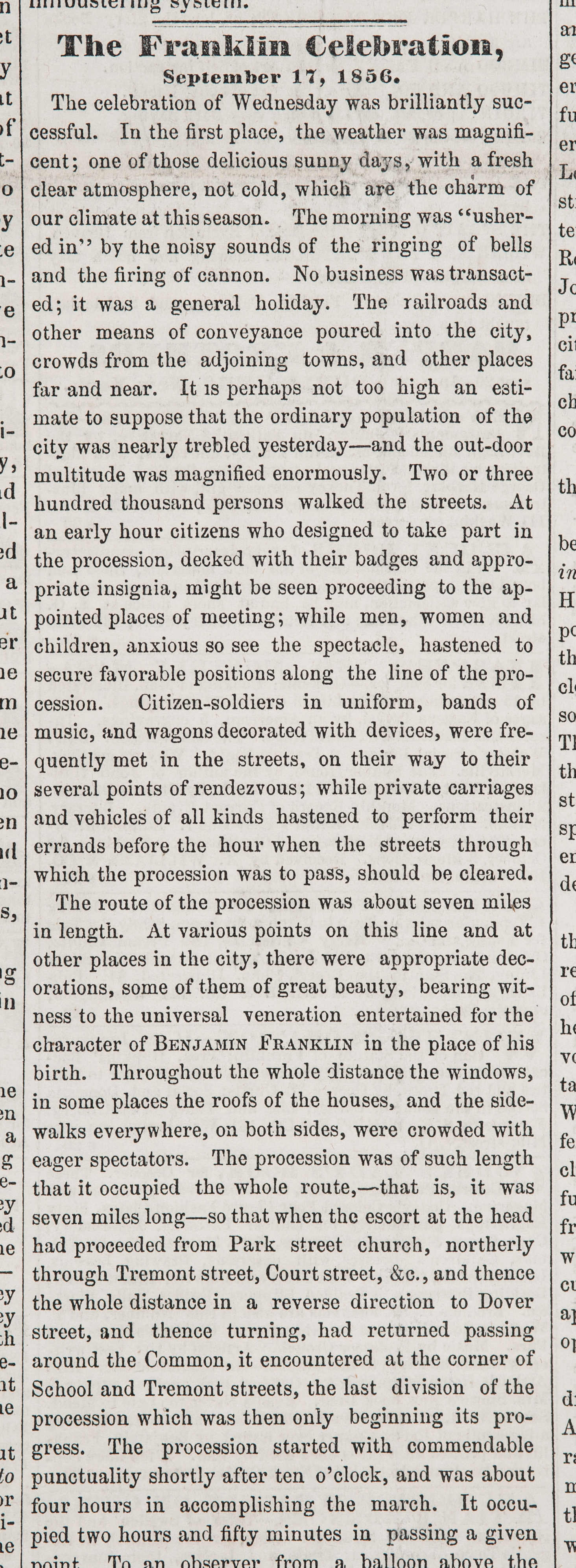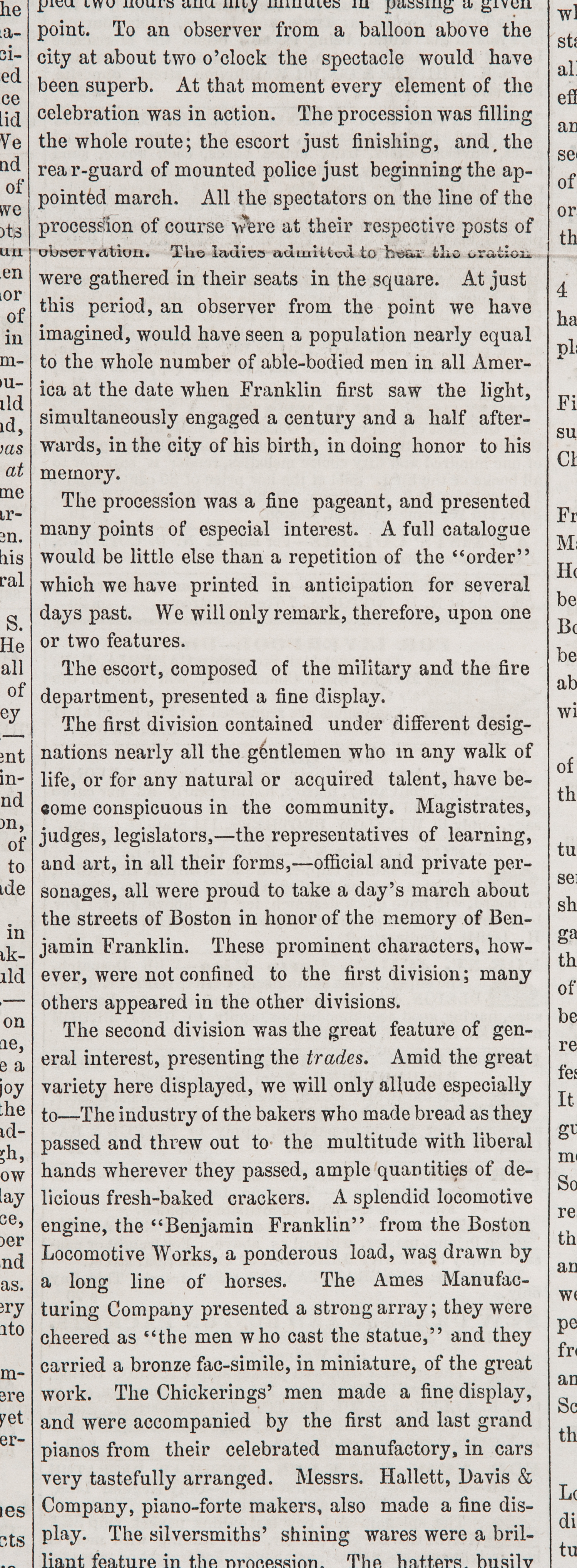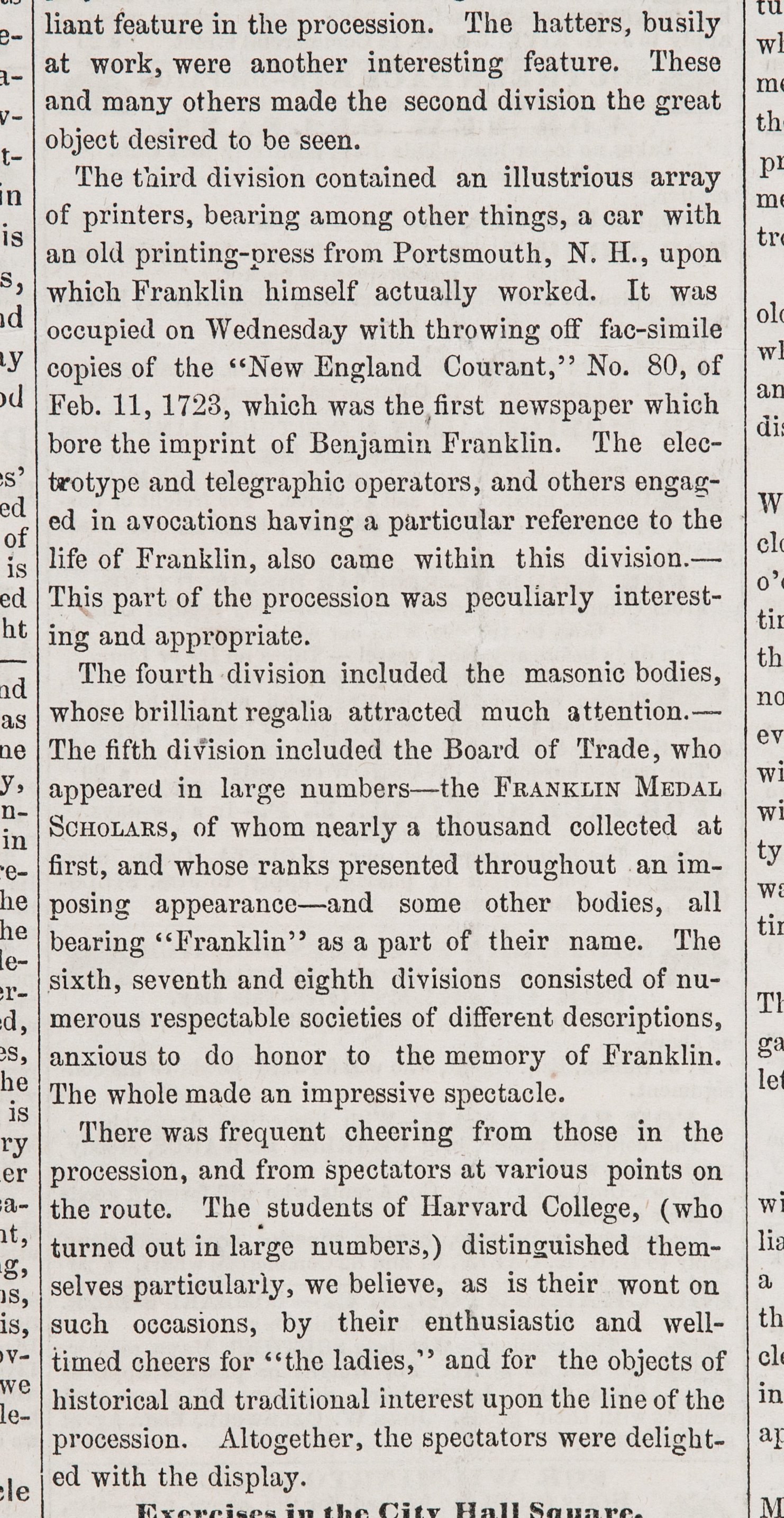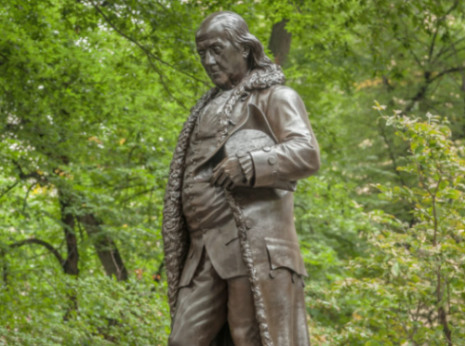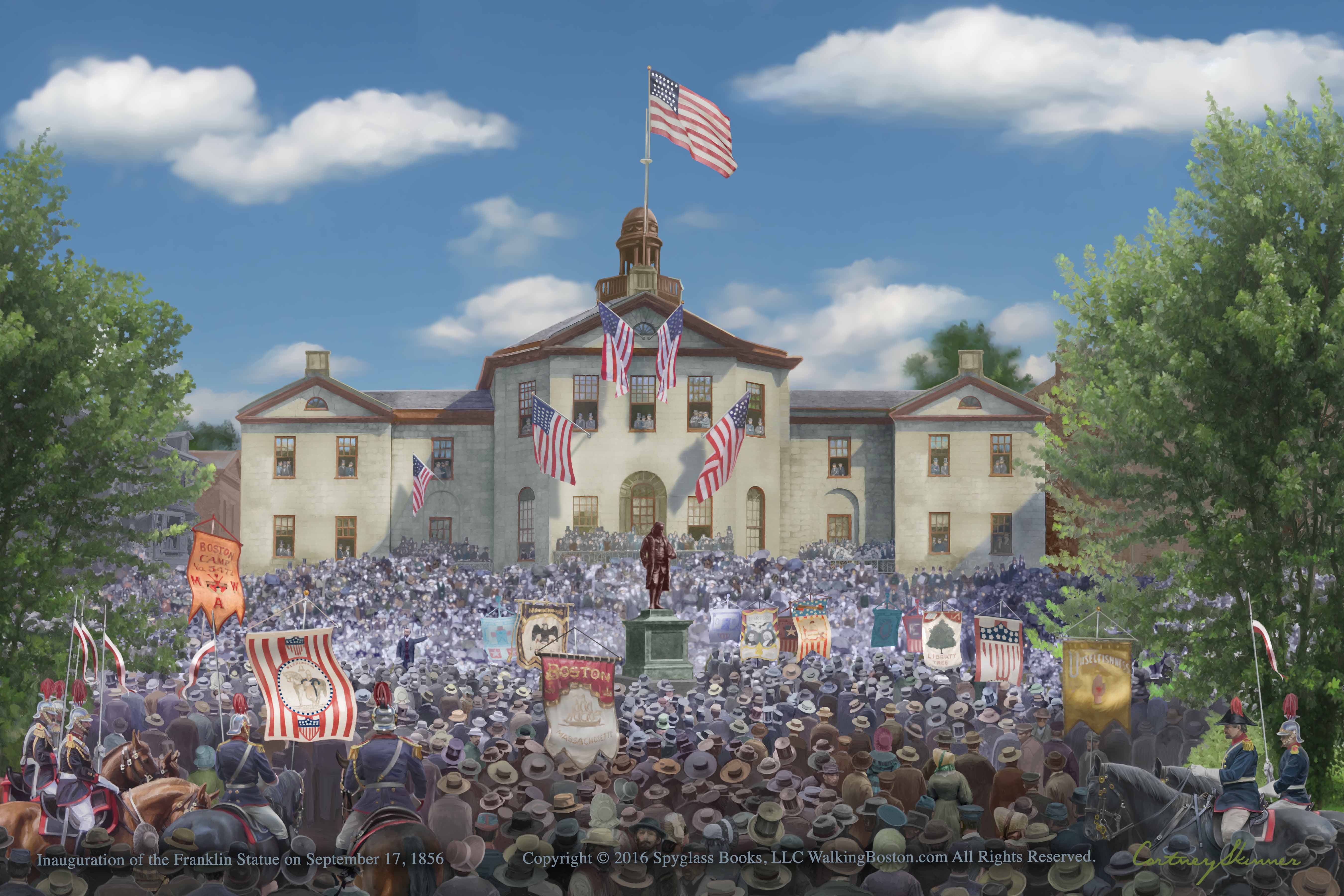Hold History
Walking Boston Lets You Hold History In Your Hands
Ben’s Collection of Rare Documents and Historic Newspapers
Hold History
Ben’s Collection of Rare Documents and Historic Newspapers
Inauguration of the Franklin Statue
A portion of a lengthy article on the Franklin Celebration of September 17, 1856 that appeared in the September 20, 1856 issue of the Boston Semi-Weekly Advertiser. This historic newspaper is part of our collection. A recent photo of the statue of Benjamin Franklin—click to see the full image.
Original press coverage of the Inauguration of the Benjamin Franklin Statue in Boston on September 17, 1856
Benjamin Franklin (1706-1790) A printer, author, freemason, scientist, inventor, statesman, diplomat, one of the Founding Fathers of the United States of America and signer of the Declaration of Independence and the United States Constitution.
The September 20, 1856 issue of the Boston Semi-Weekly Advertiser contained extensive press coverage of the events celebrating the Inauguration of the Benjamin Franklin Statue that occurred three days earlier on Wednesday, September 17, 1856. The crowds that gathered that day for the procession and the unveiling of the statue were huge. The article, written two days before it was published, notes:
It is perhaps not too high an estimate to suppose that the ordinary population of the city was nearly trebled yesterday—and the out-door multitude was magnified enormously. Two or three hundred thousand persons walked the streets.
The book Memorial Of The Inauguration Of The Statue Of Franklin, printed in Boston in 1857, contains the following:
The procession was considered by all observers to be one of the grandest and most extensive, both as regards its length, and the great degree of ornament displayed, that was ever witnessed in the streets of Boston. The features distinguishing it from all others were its peculiarity and originality. It was composed of persons of all classes, and of every condition in life; citizens of every grade and occupation striving with each other in adding to the great show of the unexampled demonstration. There were few parts of the pageant, indeed, in which a special connection with the great Bostonian was not evident. The military, the firemen, the members of the various trades and professions, the different societies and associations—literary, scientific, benevolent and religious—were all represented on the memorable occasion, and all seemed to have some appropriate reference or connection with the distinguished individual whose remembrance they seemed determined should always be green in the city of his birth, which he had honored by his integrity and uprightness, by his science and philosophy, by his wisdom and prudence, and by his living friendship and his dying bequests. The spirit of the remarkable man seemed to pervade every part of the magnificent array.
The book goes on to state that the procession was about five miles in length while the article in the Boston Semi-Weekly Advertiser of September 20, 1856 (see below) says it was two miles longer. Both agree that it took two hours and fifty minutes to pass a given point.
From the Boston Semi-Weekly Advertiser of September 20, 1856:
The route of the procession was about seven miles in length. At various points on this line and at other places in the city, there were appropriate decorations, some of them of great beauty, bearing witness to the universal veneration entertained for the character of BENJAMIN FRANKLIN in the place of his birth. Throughout the whole distance the windows, in some places the roofs of the houses, and the sidewalks everywhere, on both sides, were crowded with eager spectators. The procession was of such length that it occupied the whole route,—that is, it was seven miles long—so that when the escort at the head had proceeded from Park street church, northerly through Tremont street, Court street, &c., and thence the whole distance in a reverse direction to Dover street, and thence turning, had returned passing around the Common, it encountered at the corner of School and Tremont streets, the last division of the procession which was then only beginning its progress. The procession started with commendable punctuality shortly after ten o’clock, and was about four hours in accomplishing the march. It occupied two hours and fifty minutes in passing a given point. To an observer from a balloon above the city at about two o’clock the spectacle would have been superb. At that moment every element of the celebration was in action. The procession was filling the whole route; the escort just finishing, and the rear-guard of mounted police just beginning the appointed march. All the spectators on the line of the procession of course were at their respective posts of observation. The ladies admitted to hear the oration were gathered in their seats in the square. At just this period, an observer from the point we have imagined, would have seen a population nearly equal to the whole number of able-bodied men in all America at the date when Franklin first saw the light, simultaneously engaged a century and a half afterwards, in the city of his birth, in doing honor to his memory.
The September 20 article concluded with the following words:
The celebration was worthy the great man who was its hero. If from another world he were permitted to witness it, we believe it would afford him honest gratification to find how deeply and universally BENJAMIN FRANKLIN is honored in BOSTON.
View a complete transcript of the articles in the September 17 and 20 issues of the Boston Semi-Weekly Advertiser to learn far more details about the Franklin Celebration.
Private tour guide Ben Edwards stops by the Franklin statue on his tour of Boston’s Freedom Trail. The statue has special meaning to him as Ben’s sixth great grandfather, Captain Benjamin Edwards (1685-1751), lived in the North End of Boston when Benjamin Franklin was born on January 17, 1706. In 1722, after surviving a battle with pirates in the Caribbean, Captain Edwards returned to Boston just as a 16-year-old Benjamin Franklin’s Silence Dogood letters began appearing in The New England Courant.
In 2016, Ben had artist Cortney Skinner produce a painting called Inauguration of the Franklin Statue on September 17, 1856. Cortney Skinner and Ben Edwards have worked together for over 16 years, their initial project being Ben’s children’s book One April in Boston: The Gift of the Spyglass. Cortney’s research notes on his most recent painting follow:
In my research for creating the painting shown below called Inauguration of the Franklin Statue on September 17, 1856, I began by using as a “template” for the scene an engraving of the event that appeared in the October 11, 1856 issue of Ballou’s Pictorial. Issues of the Boston Semi-Weekly Advertiser from September 17 and 20, 1856 were also helpful as they provided details of the festivities and descriptions of the statue. One article stated, “The statue is mounted on a pedestal of which the foundation is granite, surmounted by a block of “verd-antique” marble, on each of the four sides of which will be placed a bas-relief representing a prominent scene in Franklin’s life. These are not quite yet finished.” From this article, I knew that the bas-reliefs were not installed at the time of the inauguration, so I didn’t include them. I was lucky to have found early photographs and stereoviews of the 1810 Suffolk County Courthouse—the building in front of which the inauguration was held. Built in 1810 and designed by Charles Bulfinch, it functioned as county court, a U.S. court, and the Boston City Hall but was demolished in 1863. Researching a book on Bulfinch I found that it was built of “hammered granite”, a detail I needed that was not apparent in the reference photographs.
According to the contemporaneous articles, the grounds and garden in front of the courthouse had platforms erected for the attendees which, from the engraving, resembled grandstands, lifting the multitudes attending the event above ground level, overlooking the courthouse grounds. The parade banners seen in the painting are based on early 19th century banners used by fraternal organizations, patriotic associations and tradesmen’s guilds, all of which attended the festivities according to the engraving and the newspaper reports. The mounted lancers, also seen in the engraving, were most likely civilian organizations rather than actual military troops. Militarily attired and equipped civilian commemorative organizations were popular in the early 19th century. Each of the thousands of attendees are dressed in proper early 19th century fashions. All classes of people attended the event as can be seen in the engraving, so I included working class as well as more upper class spectators. In the engraving you can see a man to the left of the statue, gesticulating with his left hand toward Franklin. I matched that in my painting, assuming him to be the Honorable Robert Charles Winthrop, the main orator who spoke during the ceremony, according to the newspaper article. He was a relative of John Winthrop and President of the Massachusetts Historical Society from 1855-1885 who had earlier served as a member of the U.S. House of Representatives from Massachusetts and a U.S. Senator from Massachusetts.
Next page: Original press coverage of the Departure of the 54th Massachusetts Regiment in Boston on May 28, 1863.

